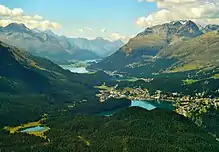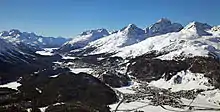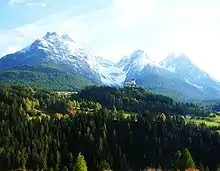Engadin
The Engadin or Engadine (/ˈɛŋɡədiːn/ ENG-gə-deen,[1] also US: /ˌɛŋɡəˈdiːn/ ENG-gə-DEEN;[2][3] Romansh: ![]() Engiadina;[note 1] German: Engadin; Italian: Engadina; French: Engadine) is a long high Alpine valley region in the eastern Swiss Alps in the canton of Graubünden in southeasternmost Switzerland with about 25,000 inhabitants. It follows the route of the Inn (Romansh: En) from its headwaters at Maloja Pass in the southwest running roughly northeast until the Inn flows into Austria, one hundred kilometers downstream.[4] The En/Inn subsequently flows at Passau into the Danube, making it the only Swiss river to drain into the Black Sea. The Engadine is protected by high mountain ranges on all sides and is famous for its sunny climate, beautiful landscapes and outdoor activities.
Engiadina;[note 1] German: Engadin; Italian: Engadina; French: Engadine) is a long high Alpine valley region in the eastern Swiss Alps in the canton of Graubünden in southeasternmost Switzerland with about 25,000 inhabitants. It follows the route of the Inn (Romansh: En) from its headwaters at Maloja Pass in the southwest running roughly northeast until the Inn flows into Austria, one hundred kilometers downstream.[4] The En/Inn subsequently flows at Passau into the Danube, making it the only Swiss river to drain into the Black Sea. The Engadine is protected by high mountain ranges on all sides and is famous for its sunny climate, beautiful landscapes and outdoor activities.

Etymology
The Romansh toponym Engiadina was first attested as Latin vallis Eniatina in AD 930. A derivation from the reconstructed ethnonym *Eniates (with a Celtic suffix -ates denoting "settlers, inhabitants", as in Licates or Atrebates) has been suggested, with the first part of the ethnonym in turn containing the name of the En (Aenus (Enus)).[5] By that derivation the name would mean lit. '"Valley of the Inn people"'.
Geography

The Engadine lies at the most southeastern end of Switzerland and at the western end of the Eastern Alps and constitutes the Swiss part of the 130 kilometres (81 mi)-long valley drained by the En/Inn until it turns northeast again after a large bend to northwest just before Landeck in Austria (the Austrian part is simply called Inntal aka Inn Valley). From the Maloja Pass (1,815 m (5,955 ft)) to the border of the Austrian Tyrol just before the Schergenbach, coming from Samnaun, enters the Inn, it runs for the whole Swiss length of 100 kilometres (62 mi) always above 1,000 metres (3,300 ft) in elevation.
The Engadine is connected by the Julier, Albula, Flüela Passes and the Vereina Tunnel to the northern part of Switzerland and the rest of the canton of Grisons. It is reachable from northern Italy by the Maloja Pass to the west and the Bernina Pass to the south. Via the Pass dal Fuorn (German: Ofenpass) it connects to the southern Val Müstair (German: Münstertal) and further south over the border to the Val Venosta (German: Vinschgau) in Italy.
The highest mountains of the wider area of the Engadine is the Bernina Range in the southwestern part. The formation of the Engadine is linked to the activity of the Engadine Line.
The Engadine is traditionally divided into two parts:
- The Upper Engadine, from Maloja Pass to the dell near Brail,[4] in the west, where the valley stays fairly flat and is remarkably wide (up to 1.5 km (0.93 mi)) as far as S-chanf. Its major center is St. Moritz and very bustling during touristic peak seasons, winter and summer. The traditionally spoken Romansh idiom in the Upper Engadine is called Putèr.[4]
- The Lower Engadine, from Brail to the Austrian border in the far east, where the Inn drops more quickly, runs now more eastwards after Susch, the valley becomes narrower and steeper, and the En's path is more tortuous, the area is much more secluded and therefore more quiet; its major center is Scuol (1,243 m (4,078 ft)). The traditionally spoken Romansh idiom in the Lower Engadine is called Vallader.[4]
Upper Engadine
The Upper Engadine (Romansh: Engiadin'Ota;[note 2] German: Oberengadin) begins at the Maloja mountain pass (1,815 m (5,955 ft)) in the southwest with a subsequent chain of lakes running southwest–northeast: Lej da Segl (English: Lake Sils, German: Silsersee), Lej da Silvaplauna (English: Lake Silvaplana, German: Silvaplanersee), both famous for windsurfing, and Lej da San Murezzan (1,768 m (5,801 ft); English: Lake St. Moritz, German: St. Moritzersee). To the southwestern side, the Maloja Pass drops precipitously down to the Italian spoken Val Bregaglia (German: Bergell) and then over the Swiss-Italian border further down to Chiavenna (325 m (1,066 ft)), and thence southwards to Como. Near the Lunghin Pass (2,645 m (8,678 ft)), northwest from and above Maloja, lies the most notable triple watershed in Western Europe, from where the water flows via the Inn and then via the Danube to the Black Sea, via the Maira and then via the Po to the Mediterranean Sea, and via the Gelgia and then via the Rhine to the North Sea.
The resort of St. Moritz at around 1,800 metres (5,900 ft) sits on Lej da San Murezzan. It was the host city for the 1928 and 1948 Winter Olympics. There are numerous ski resorts in the area served by the ski areas of Piz Corvatsch and Piz Nair.


Northeast of St. Moritz lies the village of Samedan, which is the capital of the Upper Engadine.[6] Near Samedan, the river Flaz joins the Inn from the south and the valley opens into a wide meadow framed with mountains. The Flaz is a major tributary which flows north, down the Val Bernina starting in Pontresina at the confluence of the Ova da Roseg and Ova da Bernina. Here, on the flat between those two rivers one also finds the Engadin Airport.
The highest mountain in the wider area of the Engadine – and in the Eastern Alps – is Piz Bernina, which is 4,049 metres (13,284 ft) high and 15 kilometres (9.3 mi) southeast of St. Moritz.
Further down from Samedan to the northeast are a number of villages lying on the banks of the Inn. One of it is Zuoz (1,720 m (5,640 ft)), which is a village of typical Engadine houses, with large, thick stone and masonry walls, funnel-shaped windows, and wall paintings called sgraffito. These houses are large and are traditionally shared by two or more families, and they may have what used to be a stable or livestock area underneath. In a typical Engadine village, there are numerous fountains, free-flowing all year round, which were formerly used for drinking water, washing, and for watering livestock.
The red trains by Rhaetian Railways (RhB) connects St. Moritz with Samedan and runs mainly on a north–south axis via the Albula Tunnel to the north and connects the Upper Engadine via Filisur and Thusis with Chur, the capital of the canton and consequently with the rest of Switzerland, and to the south via the Bernina Pass (2,253 m (7,392 ft), the highest traverse of a train in Europe) through the Val Bernina on its northern side and the Swiss but Italian spoken Val Poschiavo on its southern side with Tirano in Italy.
The RhB also connects the Upper Engadine with the Lower Engadine as far as Scuol, and connects the Lower Engadine since 1999 via the Vereina Tunnel to Klosters and the Prätigau; another connection to the rest of Switzerland. In the summer, the Albula Pass is also open for car travel. The Julier Pass, north above St. Moritz, connects the Engadine with the rest of Graubünden for the whole year. Regular Swiss PostBus lines connects the Upper Engadine with the Val Bregaglia, Chiavenna in Italy, and even further to Lugano in Switzerland again in the west.
Immediately next to northeast of Zuoz is the village of S-chanf, which is the end of the large flat meadows next to the Inn. Every year, there is a famous mass-cross-country ski race called the Engadin Skimarathon from Maloja, across the frozen lakes and over the open meadows and ending in S-chanf; 11'000 to 13'000 skiers participate every year.
Below S-chanf the landscape suddenly changes. The Inn, now rather wild, flows through a deep gorge with steep walls and meadows give way to larch woods. At Zernez, the Inn valley opens up again for a short distance. In Zernez (1,470 m (4,820 ft)) the Fuorn Pass goes south, passing through the Val del Spöl on its north side, where one part of the Swiss National Park is also to be found, to the Italian spoken Val Müstair (German: Münstertal) on its south side.
The border between the Upper and Lower Engadine is at the dell near Brail.[4]
Lower Engadine

With Brail the Lower Engadine (Romansh: Engiadina Bassa;[note 3] German: Unterengadin) begins. Here the villages are no longer located on the valley floor, with the exception of Zernez, but higher up on sunny terraces formed during glacial periods.
To the north, another train route connects the Lower Engadine with Klosters (and Davos) in the Prätigau via the recently built Vereina Tunnel. And further via Landquart to Chur or Zurich. The capital of the Lower Engadine is the ski and spa resort Scuol at around 1,200 metres (3,900 ft). At the very end of the Engadine, a curvaceous mountain road through the deep gorge-like Val da Tschera, not build before 1912,[4] connects to the remote, very secluded and duty-free ski resort Samnaun, which shares a huge ski area with Austrian Ischgl.
Samnaun, as well as all larger and even most smaller villages in the main valley or its side valleys, is connected by regular PostBus Switzerland services with RhB stations either in Scuol or any other stop further up the main valley. Regular bus services connects Scuol also via Martina and the Austrian Pfunds with the Landeck-Zams in the Tyrolian Upper Inn Valley (German: (Tiroler) Oberinntal). Here you meet the main railway line between Zurich – Innsbruck – Salzburg – Vienna. PostBus Switzerland also connects the main valley from Zernez with the Val Müstair or even further to the South-Tyrolian Mals, and by an Italian bus service back to the Lower Engadine via Martina, or vice versa.
Demographics
In the Upper Engadine, as a result of the strong influx of people related to tourism, mainly from outside of Switzerland (mainly from Italy, Austria, Germany), the number of (Swiss) German and Italian speakers outnumber Romansh speakers, and in the heavily touristed village of St. Moritz there are few Romansh speakers to be found. In the Lower Engadine, Romansch is still the most widely spoken language, but almost all of the people also speak the Grisonian Swiss German and (the Swiss variety of) Standard German as a second and third language. Most place signs in both the Upper and Lower Engadine show both languages (German/Italian and Romansh), e.g. St. Moritz - San Murezzan, Sils - Segl, Celerina - Schlarigna.
Lakes
| Lake | Area | Elevation |
|---|---|---|
| Lake Sils | 4.1 km2 | 1797 m |
| Lake Silvaplana | 2.7 km2 | 1791 m |
| Lake Champfèr | ||
| Lake St. Moritz | 0.78 km2 | 1768 m |
Traditions
Though no one knows how far back it dates, the traditional winter horse-drawn sleigh ride takes place every winter. Many of the sleighs once came from local families who have been living in the area over many generations. The fact that their carriages go as far back as they do, helps to identify the tradition as one that has possibly been around for centuries.
The Schlittéda ("sleigh ride"- the word Schlittenfahrt has an equivalent meaning) is composed of many sleighs, each carrying a young woman and a young man paired up by a lottery, and one sleigh carrying a musician or group of musicians to serenade the riders and the accompanying audience.
Typical black and red Engadine dress is used by the townspeople and the horses are decorated with plumage and trimmings in addition to the bells. Throughout the day-long ride, stops, that have been planned ahead of time, are made where eating, dancing, and drinking occur. At the end of the night, the young woman's companion (who had been selected by lottery) is invited to her home for more celebratory dining.
Notes
- This is the name in the two Romansh idioms that are spoken in the Engadin, Vallader and Puter, as well as in Sursilvan and Rumantsch Grischun. In Surmiran, the name is Nagiadegna, and in Sutsilvan, it is Gidegna.
- This is the name in the Romansh idiom that is spoken in the Upper Engadine, Puter, as well as in Vallader and Rumantsch Grischun. In Surmiran, the name is Nagiadegna ota, and in Sutsilvan, it is Gidegn'Òlta.
- This is the name in the Romansh idioms that are spoken in the Engadin, Vallader and Puter, as well as in Rumantsch Grischun. In Surmiran, the name is Nagiadegna bassa, and in Sutsilvan, it is Gidegna Bassa.
References
- "Engadine". Collins English Dictionary. HarperCollins. Retrieved 2 August 2019.
- "Engadine". The American Heritage Dictionary of the English Language (5th ed.). Boston: Houghton Mifflin Harcourt. Retrieved 2 August 2019.
- "Engadine". Merriam-Webster Dictionary. Retrieved 2 August 2019.
- Ottavio Clavuot: Engadin in Romansh, German, French and Italian in the online Historical Dictionary of Switzerland, 2014-09-04.
- Hans Lieb: Eniates in German, French and Italian in the online Historical Dictionary of Switzerland, 2015-12-22.
- Coolidge, William Augustus Brevoort (1911). . In Chisholm, Hugh (ed.). Encyclopædia Britannica. 9 (11th ed.). Cambridge University Press. p. 404.
External links
| Wikivoyage has a travel guide for Engadin. |
| Wikimedia Commons has media related to Engadin. |
- Engiadina in Romansh, German, French and Italian in the online Historical Dictionary of Switzerland, 2014-04-09.
- Culture archive of the Engadin
- Engadin pictures - Photos of the Engadin
- Webcams of the Engadin
- Vegetation map Upper Engadine, 1:50'000, GIS, June 2010 ISBN 978-3-033-02480-9